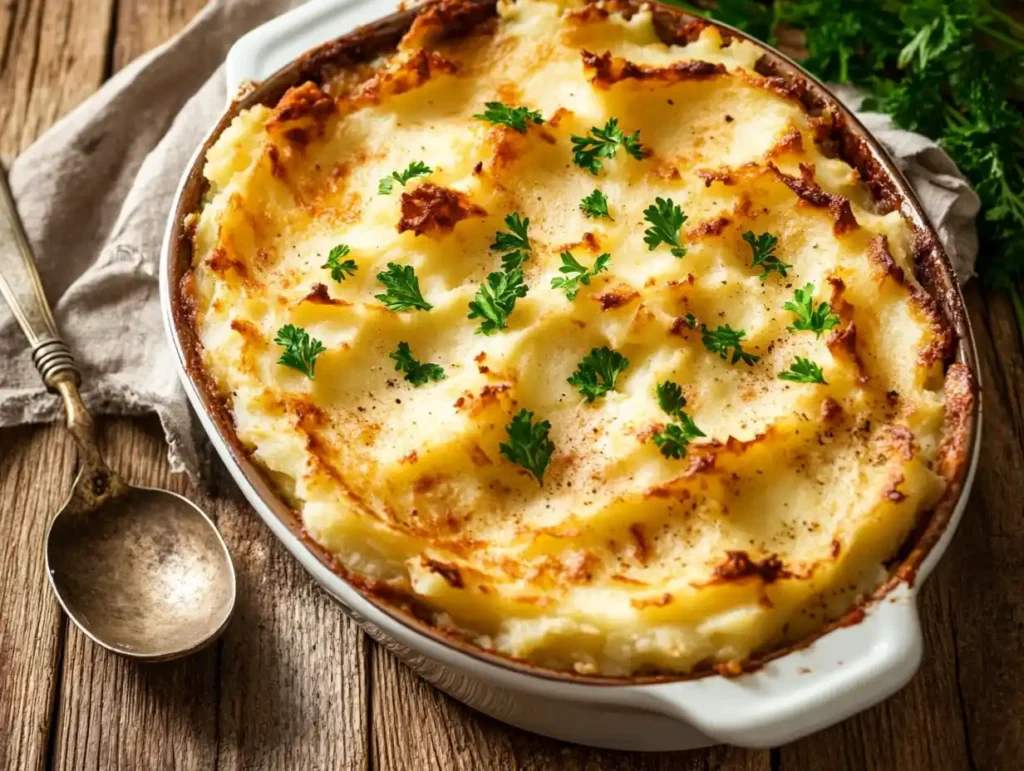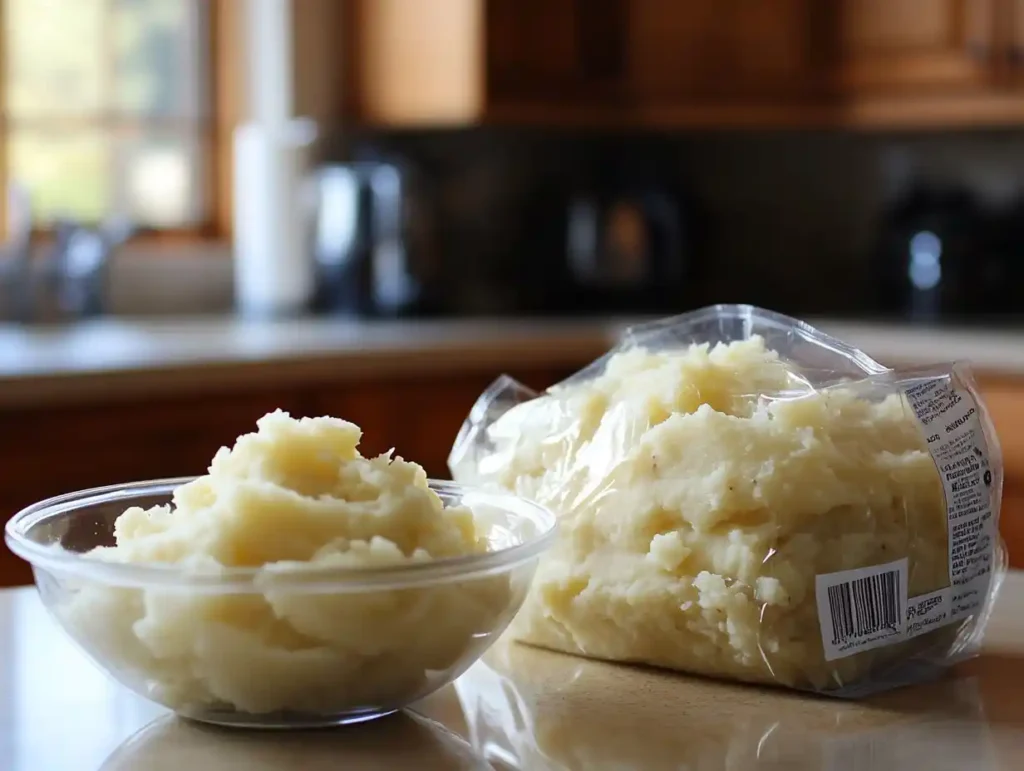Introduction
Life moves fast, and cooking meals from scratch isn’t always an option. Frozen mashed potatoes solve this problem, offering a quick and delicious side dish without the hassle.
These ready-to-use potatoes bring the creamy, comforting taste you love with none of the effort. Perfect for busy parents, professionals, or beginner cooks, they’re an easy way to enjoy a classic favorite.
This article covers everything about frozen mashed potatoes, including benefits, recipes, and storage tips. Discover why they belong in every freezer!
What Are Frozen Mashed Potatoes?
Frozen mashed potatoes deliver a quick and hassle-free way to enjoy this classic comfort food. Manufacturers cook, season, and freeze the mashed potatoes to preserve their flavor and texture. This convenient option eliminates the need to peel, boil, and mash fresh potatoes, saving you time and effort in the kitchen.
You can find them in various forms, such as plain mashed potatoes, buttered varieties, or those flavored with garlic and herbs. Stores typically package them in portioned sizes, which makes it easy to prepare the right amount for any meal.
How Do Manufacturers Make Them?
The production process begins with fresh, high-quality potatoes. Workers peel, cook, and mash the potatoes before blending in ingredients like butter, cream, or seasonings. Once mixed, they portion and flash-freeze the mashed potatoes, which locks in their freshness. This method ensures that the product retains its creamy texture and original taste when reheated.
Types of Frozen Mashed Potatoes
To meet different needs and preferences, companies offer a variety of frozen mashed potatoes:
- Plain Mashed Potatoes: These contain no added seasoning, which allows you to customize them to your liking.
- Seasoned Varieties: These come pre-flavored with ingredients like butter, cream, garlic, or herbs, making them ready to serve.
- Specialty Options: Brands also provide options for specific diets, such as low-fat or dairy-free mashed potatoes.
With so many choices, frozen mashed potatoes can easily fit into your lifestyle, whether you need a quick side dish or a base for creative recipes.
Why Choose Frozen Mashed Potatoes?
Frozen mashed potatoes offer several benefits that make them a staple in many households. To begin with, they save time, which is especially valuable during busy weekdays. Instead of spending precious minutes peeling, boiling, and mashing potatoes, you can simply heat up frozen mashed potatoes and enjoy a delicious side dish within minutes.
Additionally, these potatoes are incredibly versatile. For example, you can use them as a base for various recipes like casseroles, soups, or savory pancakes. Moreover, their consistent texture and flavor make them an ideal choice for both quick meals and special occasions.
Finally, frozen mashed potatoes are budget-friendly. Buying pre-prepared mashed potatoes often costs less than purchasing all the fresh ingredients, especially when you consider the time and effort saved. As a result, they provide a convenient, cost-effective alternative to homemade mashed potatoes.
How Do They Save Time?
When life gets hectic, every minute counts. Frozen mashed potatoes significantly reduce meal preparation time, allowing you to focus on other tasks or simply relax. For instance, instead of juggling multiple cooking steps, you can pop the frozen potatoes in the microwave or on the stove. Consequently, you’ll have more time to prepare the rest of the meal or enjoy your evening.
In contrast, making mashed potatoes from scratch can be labor-intensive. You need to wash, peel, boil, mash, and season the potatoes. Frozen options eliminate these steps, helping you save time without sacrificing flavor.
Are They Versatile?
Absolutely! Frozen mashed potatoes adapt easily to various recipes and cuisines. For instance, you can use them as a base for shepherd’s pie or mix them with cheese and herbs for potato cakes. Furthermore, they pair perfectly with roasted meats, vegetables, or gravy, making them suitable for countless dishes.
In addition, their neutral flavor allows you to customize them easily. Whether you prefer adding garlic, sour cream, or shredded cheese, frozen mashed potatoes give you the flexibility to tailor the dish to your taste.
Step-by-Step Preparation Guide
Preparing frozen mashed potatoes is a straightforward process. Whether you are short on time or planning a detailed meal, you can have a creamy, delicious side dish ready in just a few minutes. Here’s how you can do it:
- Read the Instructions: Start by reading the cooking instructions on the package. Brands may recommend different methods based on their product.
- Choose a Cooking Method: Decide whether you will use a stovetop, microwave, or oven. Each method has its advantages, but the microwave is usually the fastest.
- Cook the Potatoes:
- For the stovetop, place the frozen mashed potatoes in a saucepan over low heat. Stir frequently to prevent sticking as the potatoes thaw and warm up.
- For the microwave, transfer the frozen potatoes to a microwave-safe dish, cover them, and heat in short intervals. Stir between intervals to ensure even heating.
- For the oven, spread the potatoes evenly in a baking dish, cover with foil, and bake until heated through.
- Add Extra Ingredients (Optional): To enhance the flavor, mix in butter, cream, or seasonings like garlic powder, black pepper, or fresh herbs.
- Serve and Enjoy: Once heated, serve the mashed potatoes immediately while they are warm and creamy.
Tips for the Best Results
To elevate your frozen mashed potatoes to restaurant-quality, consider these simple tips:
- Use Dairy for Creaminess: Adding a splash of milk or cream can make the texture smoother and richer.
- Enhance Flavor with Seasonings: A pinch of garlic powder, chives, or a sprinkle of Parmesan cheese can take the flavor to the next level.
- Avoid Overheating: Heating for too long can make the texture gummy. Stop cooking as soon as they are thoroughly warmed.
By following these tips, you can make your frozen mashed potatoes taste as good as homemade.
Common Mistakes to Avoid
Even though preparing frozen mashed potatoes is simple, a few mistakes can impact the final result. Be sure to:
- Avoid Adding Too Much Liquid: Adding excessive milk or cream can turn the potatoes into a soupy mess. Add liquid gradually to maintain the right consistency.
- Don’t Skip Stirring: Always stir the potatoes during cooking to ensure even heating and prevent them from sticking to the pan or dish.
- Use Fresh Ingredients for Enhancements: If you’re adding herbs or cheese, opt for fresh ingredients to enhance the flavor and presentation.
These small adjustments can make a big difference in how your mashed potatoes turn out.
Creative Dishes with Frozen Mashed Potatoes

Frozen mashed potatoes are not just a side dish; they can also be the base for many creative and delicious recipes. Here are a few ideas to inspire your next meal:
Shepherd’s Pie
This classic comfort dish becomes incredibly easy with frozen mashed potatoes.
Ingredients:
- 2 cups frozen mashed potatoes
- 1 pound ground beef or lamb
- 1 cup mixed vegetables (peas, carrots, or corn)
- 1 small onion, diced
- 1 cup beef broth
- 2 tablespoons tomato paste
- Salt and pepper to taste
Instructions:
- Preheat your oven to 375°F (190°C).
- Brown the ground meat in a skillet over medium heat, then add the onion and cook until soft.
- Stir in the tomato paste, beef broth, and mixed vegetables. Simmer for 5 minutes.
- Transfer the meat mixture to a baking dish and spread the heated frozen mashed potatoes evenly on top.
- Bake for 20–25 minutes or until the potatoes turn golden brown. Serve warm.
Mashed Potato Pancakes
Transform leftover mashed potatoes into crispy, golden pancakes perfect for breakfast or a snack.
Ingredients:
- 2 cups frozen mashed potatoes, thawed
- 1 large egg
- ½ cup all-purpose flour
- ¼ cup shredded cheddar cheese
- Salt and pepper to taste
- 2 tablespoons butter or oil for frying
Instructions:
- In a mixing bowl, combine the mashed potatoes, egg, flour, cheese, salt, and pepper. Mix until a dough forms.
- Shape the dough into small patties.
- Heat the butter or oil in a skillet over medium heat. Cook the patties for 3–4 minutes per side until golden brown.
- Serve with sour cream or applesauce.
Loaded Mashed Potato Casserole
This recipe takes frozen mashed potatoes to a whole new level.
Ingredients:
- 4 cups frozen mashed potatoes
- 1 cup shredded cheese (cheddar or mozzarella)
- ½ cup sour cream
- 4 strips of cooked bacon, crumbled
- 2 green onions, sliced
Instructions:
- Preheat your oven to 350°F (175°C).
- Mix the mashed potatoes with sour cream and half the cheese. Spread the mixture in a baking dish.
- Sprinkle the remaining cheese, crumbled bacon, and green onions on top.
- Bake for 20 minutes or until the cheese is melted and bubbly.
Mashed Potato Soup
This hearty soup is perfect for cold days and easy to make with frozen mashed potatoes.
Ingredients:
- 3 cups frozen mashed potatoes
- 4 cups chicken or vegetable broth
- 1 cup milk or cream
- 1 small onion, diced
- 1 tablespoon butter
- Salt, pepper, and toppings (bacon bits, cheese, or chives)
Instructions:
- Melt the butter in a large pot and sauté the onion until soft.
- Add the mashed potatoes, broth, and milk. Stir until combined.
- Simmer the soup over low heat for 10–15 minutes, stirring occasionally.
- Adjust seasoning with salt and pepper, then serve with your favorite toppings.
Nutritional Profile of Frozen Mashed Potatoes
Frozen mashed potatoes offer a balance of convenience and nutrition. They retain many of the nutrients found in fresh potatoes, such as potassium, vitamin C, and dietary fiber. However, the nutritional value can vary based on the brand and added ingredients like butter, cream, or flavorings.
Typically, a one-cup serving of plain frozen mashed potatoes contains:
- Calories: Around 100–150
- Fat: 2–4 grams (depending on added butter or cream)
- Carbohydrates: 15–25 grams
- Protein: 2–4 grams
- Fiber: 1–3 grams
Brands that use minimal additives offer a healthier option, while those loaded with cream, butter, or salt may be higher in calories and fat.
Frozen vs. Homemade Mashed Potatoes
Many people wonder if frozen mashed potatoes are as healthy as homemade ones. The answer largely depends on the preparation method and ingredients.
Homemade Mashed Potatoes: These give you full control over ingredients, allowing you to limit salt, butter, or cream. As a result, they can be lower in calories and sodium.
Frozen Mashed Potatoes: These often include preservatives, flavor enhancers, or added fats to maintain taste and texture during freezing. While convenient, some brands may contain higher levels of sodium and saturated fats.
If you prioritize health, choose frozen mashed potatoes with a short ingredient list and no artificial additives.
Potential Additives to Watch
Although frozen mashed potatoes are generally safe and convenient, certain additives may concern health-conscious consumers. Here’s what to look for on labels:
- Sodium: Some brands use salt as a preservative, which increases sodium levels. Opt for low-sodium options if available.
- Artificial Preservatives: Ingredients like monosodium glutamate (MSG) or artificial flavorings may not be necessary for taste.
- Trans Fats: Rarely, some products may include hydrogenated oils. Check for “0 grams trans fats” on the label.
By carefully reading ingredient labels, you can select a brand that aligns with your dietary needs and preferences.
Tips for a Healthier Option

If you want to make frozen mashed potatoes healthier, here are some simple tips:
- Boost Fiber: Stir in cooked vegetables like cauliflower or carrots for added fiber and nutrients.
- Control Salt: Taste before adding extra salt, as frozen varieties may already contain seasoning.
- Lighten Up: Use milk or broth instead of heavy cream to reduce fat and calories.
With these adjustments, you can enjoy the convenience of frozen mashed potatoes while keeping your meals nutritious and balanced.
FAQs About Frozen Mashed Potatoes
How long do frozen mashed potatoes last
Frozen mashed potatoes can last 6–12 months when stored properly in a consistent freezer temperature. Check the package for exact expiration dates. Discard them if the texture or smell seems unusual after reheating.
Can I make frozen mashed potatoes taste better?
Yes! Add butter, cream, garlic, herbs, or cheese to enhance their flavor. Experiment with these additions to customize them to your liking.
Are there healthy frozen mashed potato options?
Many brands offer low-fat or dairy-free options to suit different dietary needs. Look for products labeled as “vegan” or “low-sodium” for healthier choices.
Conclusion
Frozen mashed potatoes offer a perfect balance of convenience and flavor. Whether for a quick side dish or a recipe base, they save time without compromising taste. Their long shelf life and versatility make them an essential part of any kitchen. Give them a try to see how they can simplify your meals while adding comfort to your table.
Looking to explore more delicious food ideas? Check out our insights on Are Blueberry Bagels Healthy? and the perfect timing for How Long to Cook Mini Pancakes. Don’t miss our tips on the best Thickening Ingredients for Chowder.

